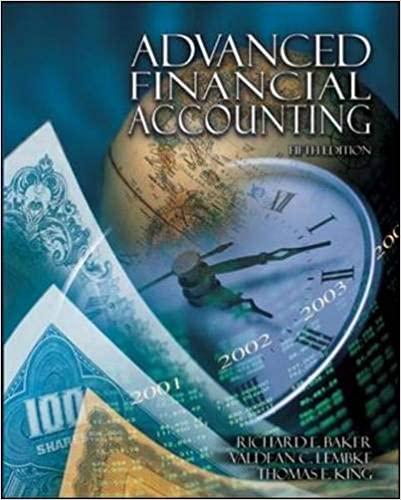Select the correct answer for each of the following questions. 1. Two interesting and important topics concerning
Question:
Select the correct answer for each of the following questions.
1. Two interesting and important topics concerning the SEC are the role the Commission plays in the development of accounting principles and the impact it has had and will continue to have on the accounting profession and business in general. Which of the following statements about the SEC's authority on accounting practice is false?
a. The SEC has the statutory authority to regulate and to prescribe the form and content of financial statements and other reports it receives.
b. Regulation S-X of the SEC is the principal source of the form and content of financial statements to be included in registration statements and financial reports filed with the Commission.
c. The SEC has little if any authority over disclosures in corporate annual reports mailed to shareholders with proxy solicitations. The type of information disclosed and the format to be used are left to the discretion of management.
d. If the Commission disagrees with some presentation in the registrant's financial statements but the principles used by the registrant have substantial authoritative support, the SEC often will accept footnotes to the statements in lieu of correcting the statements to the SEC view, provided the SEC has not previously expressed its opinion on the matter in published material.
2. The Securities and Exchange Commission was established in 1934 to help regulate the U.S. securities market. Which of the following statements is true about the SEC?
a. The SEC prohibits the sale of speculative securities.
\(b\). The SEC regulates only securities offered for public sale.
c. Registration with the SEC guarantees the accuracy of the registrant's prospectus.
d. The SEC's initial influences and authority have diminished in recent years as the stock exchanges have become more organized and better able to police themselves.
e. The SEC's powers are broad with respect to enforcement of its reporting requirements as established in the 1933 and 1934 acts but narrow with respect to new reporting requirements because these require confirmation by Congress.
3. The Securities and Exchange Commission is organized into several divisions and principal offices. The organization unit that reviews registration statements, annual reports, and proxy statements that are filed with the Commission is:
a. The Office of the Chief Accountant.
b. The Division of Corporation Finance.
c. The Division of Enforcement.
d. The Division of Market Regulation.
e. The Office of the Comptroller.
4. Regulation S-X:
a. Specifies the information that can be incorporated by reference from the annual report into the registration statement filed with the SEC.
\(b\). Specifies the regulation and reporting requirements of proxy solicitations.
c. Provides the basis for generally accepted accounting principles.
d. Specifies the general form and content requirements of financial statements filed with the SEC.
e. Provides explanations and clarifications of changes in accounting or auditing procedures used in reports filed with the SEC.
5. The Securities Exchange Act of 1934 specifies the types of companies that must report periodically to the SEC. Which one of the following types of companies is not required to report to the SEC under this act?
a. Banks subject to the Federal Reserve Board.
b. Companies whose securities are listed on the National Securities Exchange.
c. Companies whose securities are traded over the counter, if those companies have total assets in excess of \(\$ 1\) million and 500 or more stockholders.
d. Companies whose securities are traded over the counter that voluntarily elect to comply with the reporting requirements even though they have total assets less than \(\$ 1\) million and less than 500 stockholders.
e. Companies with more than 300 stockholders of a class of securities that is registered under the Securities Act of 1933.
6. Which of the following is not a purpose of the Securities Exchange Act of 1934?
a. To establish federal regulation over securities exchanges and markets.
b. To prevent unfair practices on securities exchanges and markets.
c. To discourage and prevent the use of credit in financing excessive speculation in securities.
d. To approve the securities of corporations which are to be traded publicly.
e. To control unfair use of information by corporate insiders.
7. Regulation S-K disclosure requirements of the Securities and Exchange Commission deal with the company's business, properties, and legal proceedings; selected five-year summary financial data; management's discussion and analysis of financial condition and results of operations; and:
a. The form and content of the required financial statements.
b. The requirements for filing interim financial statements.
c. Unofficial interpretations and practices regarding securities laws disclosure requirements.
d. Supplementary financial information such as quarterly financial data and information on the effects of changing prices.
\(e\). The determination of the proper registration statement form to be used in any specific public offering of securities.
Step by Step Answer:

Advanced Financial Accounting
ISBN: 9780072444124
5th Edition
Authors: Richard E. Baker, Valdean C. Lembke, Thomas E. King





